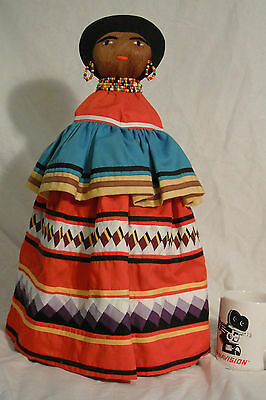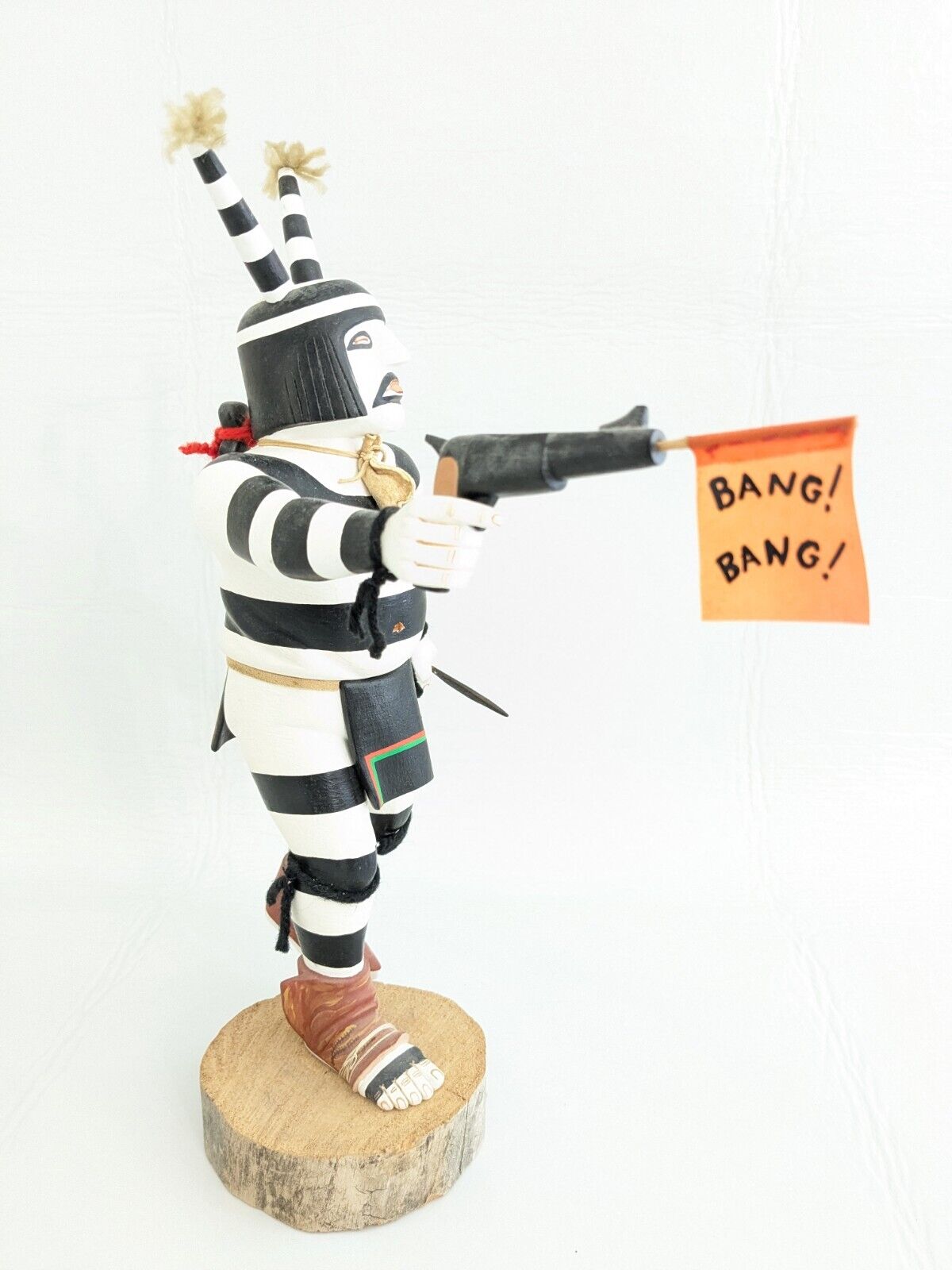-40%
Huge Pristine Seminole 19” (48.3 cm) Patchwork Doll
$ 396
- Description
- Size Guide
Description
Seminole Palm Fiber Patchwork dollMeasurement:
Height: 19” inches (48.3 cm)
Overall Width: 11” inches (27.9 cm)
Overall Depth: 9” inches (22.9 cm)
Item Description:
Up for auction an outstanding Native American “Seminole Patchwork Doll” This pristine doll stands 19” tall. This is the largest best example of this art that you will ever find. I have collected these dolls and baskets made by the Seminoles over many years. This is the best of the collection. Always save the best for last. Her face is made of palm fiber and is pristine all the features are stitched and all the threads are in excellent condition. She has marvelous beads around her neck (five rows, multiple bright colors) her earrings match. Her expression is unmatched by any example just perfect. She is sporting the 1940’s hairstyle represented as black cloth that has been stretched over a crescent cardboard frame. Her authentic dress is truly a marvelous example of Native American Seminole textile work - the beautiful bright colors and the detail of her elaborate dress. This doll’s shawl is a cascade of bright colors the proportions just so- the black rickrack appliqué a defining horizon line across the blue fabric echoed below bordering an intricate row of patchwork on her splendid dress. The patchwork pattern is white brown yellow and black and is a variant on snake jaw (I believe). The red fabric is bold and vibrant from the top to the bottom just perfect. At the bottom the patchwork is bordered by yellow rickrack appliqué reflecting back to the yellow fabric in her shawl and the Snake jaw patchwork. The bottom of the dress is adorned with patchwork that is a graduated purple from dark to light and is a variant on Diamondback Rattlesnake (I believe). This could identify the maker as from the snake clan. The craftsmanship on the body of this huge Seminole doll is clean, professional and tight. The base is cardboard covered with the smoothest fiber of the palmetto husk and is stitched with a bright pink embroidery thread. This is the highest form of this art created by a master. This is beyond rare due to its size and Seminole Dolls are also getting rarer due to the difficulty of acquiring the palmetto fiber material, the difficulty of the work and the expertise being lost to the changing world. These factors all endanger the craft.
This was purchased from the Museum in Gainesville Florida. They had had an exhibit of the Seminole crafts and culture and had purchased this large doll and baskets directly from “three elderly ladies from the Seminole tribe”. We gathered up all the baskets we could afford and this giant Seminole doll and I have never seen anything like it again. You will be amazed at the condition. All items keep dust and smoke free. See all my photos for composition and condition. The colors look a little washed out in the highlights of the pictures but the color is true to what is in shadows, all bold and bright. Email with any questions or if you need an additional photograph.
I am offering up some of the best items from my collections see what others I currently have
up for auction. I have been collecting artifacts for over 28 years and I have been a member of the EBay community since 1998
-
Please Bid with confidence.
·
Buyer info:
·
Packaging and shipping is done with care and completed in an expedient manner, shipping days are Tuesday and Thursday for gas conservation. If you have a special request we will do our best to adjust the schedule to accommodate your schedule.
·
It is my intention to be as clear and accurate as possible. In the event I make an error, I will always do my best to remedy the situation.
·
Please feel free to contact me with any questions. Please read the item description and submit any questions you might have for clarification of the item for sale prior to bidding. I can provide additional photos at the buyers request to assist you in your purchase.
·
Buyer should contact me within 3 days of auction ending, this assists in the expedient shipping.
·
Payment must be received within 5 days of auction ending.
·
Coffee cup is for scale purposes only.
Origin:
Seminole Palmetto Fiber Dolls have been promoted and marketed since the 1930’s- Seminoles and Miccosukees were hesitant to make an exact image of themselves fearing harm might come to them. The very early dolls were made of wood and cloth with little detail. However they recognized opportunity in a new booming tourist market. They began making dolls as souvenirs before 1920. Palmetto husk dolls with sewn facial features, appropriate hairstyles and dress that reflect the style of clothing at points in time. In the 1940’s the hairstyle is represented as black cloth that has been stretched over a crescent cardboard frame. The pony tail became popular in the 1950’s originally made with black silky or wool yarn. Black wool yarn was used to make two braids in the sixties. However I find dating dolls difficult because the style of the doll is determined by the preference of the doll maker rather than the year it was made. There are those knowledgeable collectors out there that can recognize the artist by their style.
I think you have to look to the patchwork to get a sense of the dolls age, the evolution of the patterns, colors and fabrics give you a better sense of the point of creation. Miccosukee speaking Indian women of south Florida are attributed with the origin of the art of making patchwork on hand cranked sewing machines on about 1910. Seminole and Miccosukee women refer to patchwork as “TAWEEKAACHE” which translates to DESIGN. Patchwork is the art of sewing different pieces of colored fabric together to create long rows of design. The development of all the patterns evolved over time as each artist found different inspiration and techniques. These like the styles of fashion for the dolls were shared and redeveloped over time. The Episcopal deaconess Harriet Bedell (1933) is attributed with starting to assign names to the designs and encouraged the artists to assign a name to their design. This facilitated their distribution in the growing special order patchwork market. Early patterns like fire are bold simple geometric patterns, but a multitude of new designs occur with alternating light and dark colors or contrasting elements. These simpler patterns redevelop over time and different methods like in the 70’s using bands of graduated colors to create a rainbow, and creating more contemporary patterns like “Big Town” bold cubes of color reflecting a contemporary Miami. The artists exchange design ideas and have samplers of designs they have made. Mary Frances Cypress of Big Cypress reservation kept a sampler of 121 variations of designs some of which came from her mother.
The Snake Jaw pattern is one of the designs of the Snake Clan. The legend of the snake is significant to this Seminole clan. However, there are many Native American tribes that will not kill snakes; this legend explains why snakes are respected and left alone.
The story goes that Snakes did not originally have teeth or fangs and were harmless creatures. One day a bad Indian saw a mother snake and her babies. He killed the babies but the mother snake escaped. She cried for three days and then went to the chief and told him about her babies being killed. The chief made some teeth for the mother and told her to bite the man if he bothered her again. Since then, many tribes will not kill a rattlesnake, believing that the snake will not bite if it is left alone.









